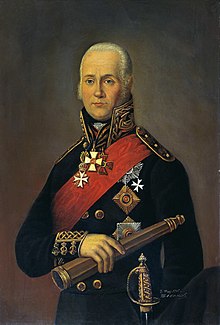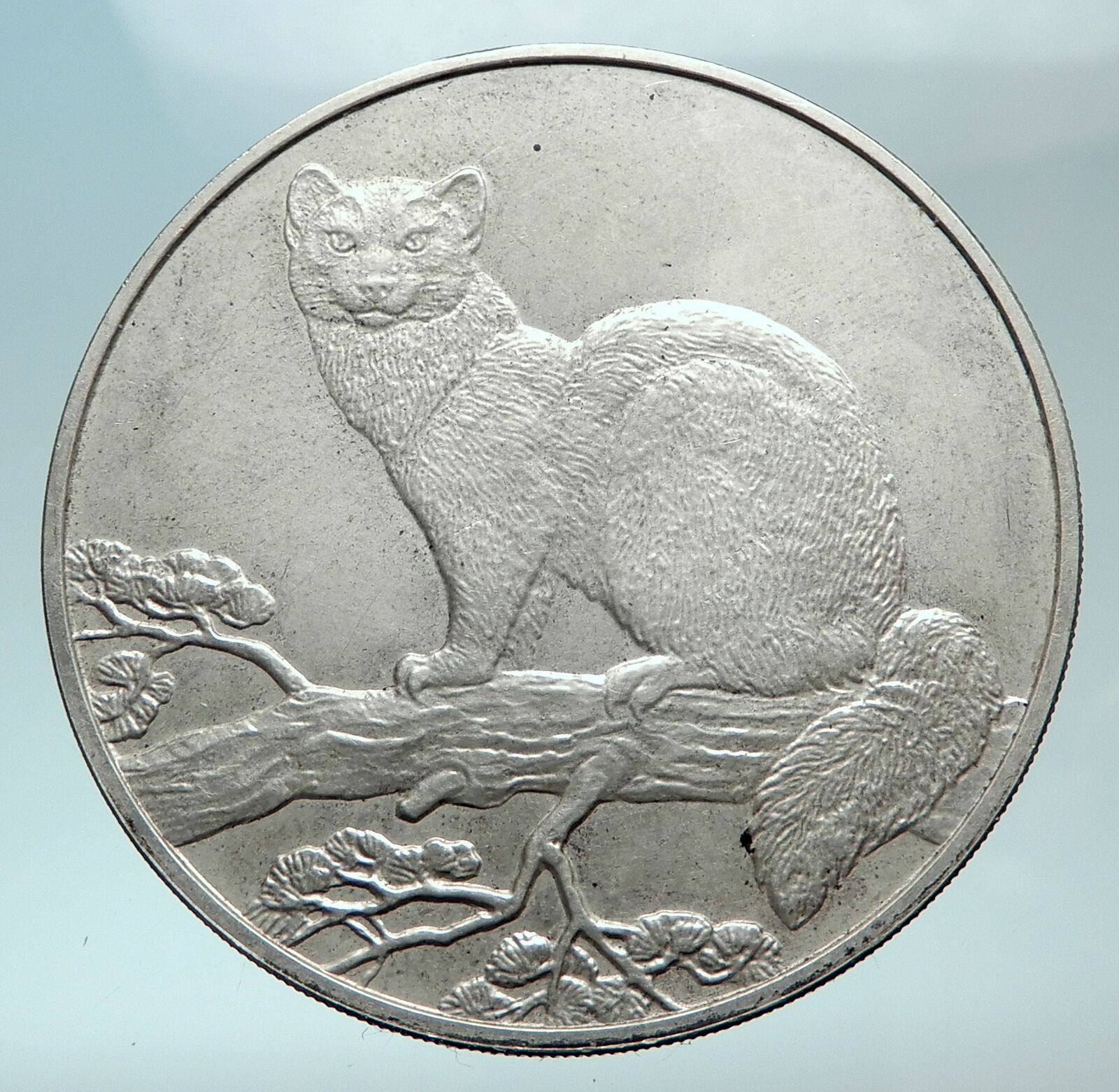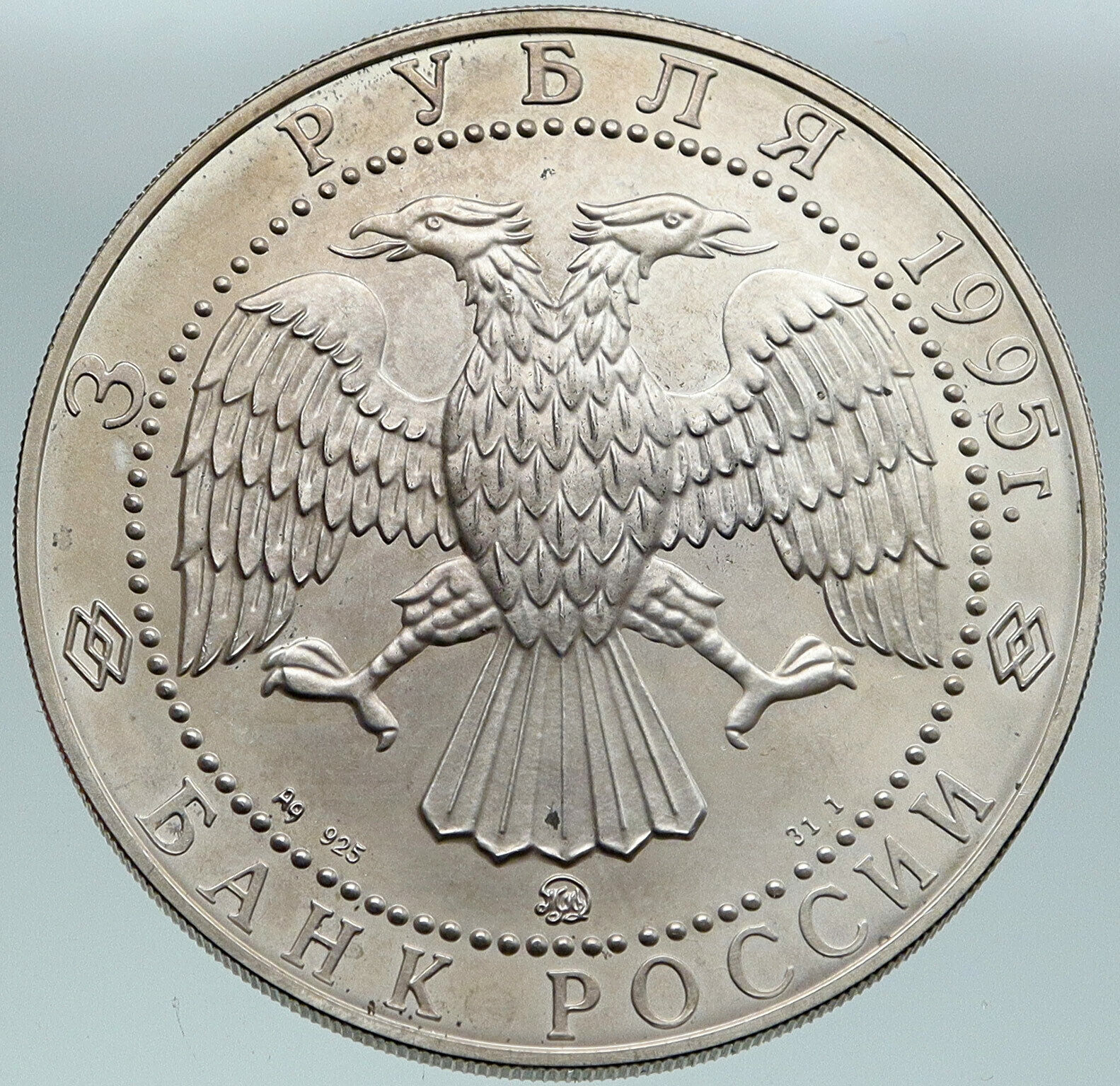|
Russia
The 250th Anniversary of the Birth of F.F. Ushakov
Series: Outstanding Personalities of Russia
1994 Proof Silver 2 Roubles 33mm (15.97 grams) 0.500 Silver (0.2551 oz. ASW)
Reference: Y# 363, CBR# 5110-0004, Schön# 349 | Engravers: A.V. Baklanov, A.A. Dolgopolova
ДВА РУБЛЯ 1994г. Ag 500 ММД 7.78 БАНК РОССИИ, The two-headed eagle (designed by I.Bilibin).
ФЁДОР УШАКОВ 1745 1817, A portrait of the Russian admiral F.F. Ushakov in military uniform with a spyglass in his hand, to the left – the Andreyevsky flag, to the right – two sailing-ships.
You are bidding on the exact item pictured, provided with a Certificate of Authenticity and Lifetime Guarantee of Authenticity.
 Fyodor Fyodorovich Ushakov (24 February [O.S. 13 February] 1745 – 14 October S. 2 October] 1817) was an 18th century Russian naval commander and admiral. He is notable for winning every engagement he participated in as the Admiral of the Russian fleet. Fyodor Fyodorovich Ushakov (24 February [O.S. 13 February] 1745 – 14 October S. 2 October] 1817) was an 18th century Russian naval commander and admiral. He is notable for winning every engagement he participated in as the Admiral of the Russian fleet.
Ushakov was born in the village of Burnakovo in the Yaroslavl gubernia, to a modest family of the minor nobility. His father, Fyodor Ignatyevich Ushakov, was a retired sergeant of the Preobrazhensky regiment of the Russian Imperial guards. By the time Fyodor Ushakov submitted his statement of background (skaska) to the military, his family had not been officially confirmed in the so-called ‘dvoryanstvo’, yet they surely belonged to serving gentry. In the submission Ushakov stated that he neither had a coat-of-arms, nor a royal patent for a landed estate, and had no way to prove nobility. In 1798, Fyodor Ushakov, as a vice-admiral of the Black Sea Navy, submitted a request for official nobility and an arms providing a genealogical record. In 1807 his coat-of-arms was added to the General all-Russian book heraldry. In 1815 Fyodor Ushakov and his family were added to the part 6 (ancient nobility) of the Yaroslavl genealogical book.
On 15 February 1761, he signed up for the Russian Navy in Saint Petersburg. After training, he served on a galley in the Baltic Fleet. In 1768 he was transferred to the Don Flotilla (Azov Sea Navy) in Taganrog, and served in the Russo-Turkish War (1768–74). He commanded Catherine II’s own yacht, and was active in protecting Russian merchant ships in the Mediterranean during the First League of Armed Neutrality.
After the Russian Empire conquered the Crimean Khanate in 1783, Ushakov personally supervised the construction of a naval base in Sevastopol and the building of docks in Kherson. During the Russo-Turkish War (1787–92), he defeated the Ottomans at Fidonisi (1788), Kerch Strait (1790), Tendra (1790), and Cape Kaliakra (1791). In these battles, he demonstrated the ingenuity of his innovative doctrines in the art of naval warfare.
In 1798 Ushakov was promoted to full admiral and given command of a squadron which sailed to the Mediterranean via Constantinople, where it joined with a Ottoman squadron. The combined Russian-Ottoman fleet then operated under Ushakov’s command in the War of the Second Coalition against the French Republic. The expedition started by conquering the Ionian islands, acquired by France the year before from the defunct Republic of Venice in the Treaty of Campo Formio. This action culminated in the Siege of Corfu (1798–1799), and led to the subsequent creation of the Septinsular Republic. Ushakov’s squadron then blockaded French bases in Italy, notably Genoa and Ancona, and successfully assaulted Naples and Rome.
Tsar Paul, in his capacity as the Grand Master of the Order of St. John, ordered Ushakov to proceed to Malta, which a British fleet under Nelson was assisting in besieging.
However, after rendezvousing with the Coalition forces on Malta, Ushakov was almost immediately recalled back home to Russia in 1800 (along with his fleet), where the new Emperor, Alexander I, failed to appreciate his victories. Ushakov resigned command in 1807 and withdrew into the Sanaksar Monastery in modern-day Mordovia. He was asked to command the local militia during the Patriotic War of 1812 but declined.
Distinguishing features of Ushakov’s tactics were: use of unified marching and fighting orders; resolute closing to close quarters with the enemy forces without evolution of a fighting order; concentration of effort against enemy flagships; maintaining a reserve (Kaiser-flag squadrons); combination of aimed artillery fire and maneuvering; and chasing the enemy to its total destruction or capture. Giving great value to sea and fire training of his staff, Ushakov was a supporter of generalissimo Suvorov’s principles of training for sailors and officers. Ushakov’s innovations were among the first successful developments of naval tactics, from its “line” to maneuvering concepts.
 Russia (Russian: Росси́я, tr. Rossiya), also officially known as the Russian Federation (Russian: Российская Федерация, tr. Rossiyskaya Federatsiya), is a country in Eurasia. At 17,125,200 square kilometres (6,612,100 sq mi), Russia is the largest country in the world by surface area, covering more than one-eighth of the Earth’s inhabited land area, and the ninth most populous, with over 144 million people at the end of March 2016. The European western part of the country is much more populated and urbanised than the eastern; about 77% of the population live in European Russia. Russia’s capital Moscow is one of the largest cities in the world; other major urban centers include Saint Petersburg, Novosibirsk, Yekaterinburg, Chelyabinsk, Nizhny Novgorod, Ufa and Kazan. Russia (Russian: Росси́я, tr. Rossiya), also officially known as the Russian Federation (Russian: Российская Федерация, tr. Rossiyskaya Federatsiya), is a country in Eurasia. At 17,125,200 square kilometres (6,612,100 sq mi), Russia is the largest country in the world by surface area, covering more than one-eighth of the Earth’s inhabited land area, and the ninth most populous, with over 144 million people at the end of March 2016. The European western part of the country is much more populated and urbanised than the eastern; about 77% of the population live in European Russia. Russia’s capital Moscow is one of the largest cities in the world; other major urban centers include Saint Petersburg, Novosibirsk, Yekaterinburg, Chelyabinsk, Nizhny Novgorod, Ufa and Kazan.
 Extending across the entirety of Northern Asia and much of Eastern Europe, Russia spans eleven time zones and incorporates a wide range of environments and landforms. From northwest to southeast, Russia shares land borders with Norway, Finland, Estonia, Latvia, Lithuania and Poland (both with Kaliningrad Oblast), Belarus, Ukraine, Georgia, Azerbaijan, Kazakhstan, China, Mongolia and North Korea. It shares maritime borders with Japan by the Sea of Okhotsk and the U.S. state of Alaska across the Bering Strait. Extending across the entirety of Northern Asia and much of Eastern Europe, Russia spans eleven time zones and incorporates a wide range of environments and landforms. From northwest to southeast, Russia shares land borders with Norway, Finland, Estonia, Latvia, Lithuania and Poland (both with Kaliningrad Oblast), Belarus, Ukraine, Georgia, Azerbaijan, Kazakhstan, China, Mongolia and North Korea. It shares maritime borders with Japan by the Sea of Okhotsk and the U.S. state of Alaska across the Bering Strait.
The East Slavs emerged as a recognizable group in Europe between the 3rd and 8th centuries AD. Founded and ruled by a Varangian warrior elite and their descendants, the medieval state of Rus arose in the 9th century. In 988 it adopted Orthodox Christianity from the Byzantine Empire, beginning the synthesis of Byzantine and Slavic cultures that defined Russian culture for the next millennium. Rus’ ultimately disintegrated into a number of smaller states; most of the Rus’ lands were overrun by the Mongol invasion and became tributaries of the nomadic Golden Horde in the 13th century. The Grand Duchy of Moscow gradually reunified the surrounding Russian principalities, achieved independence from the Golden Horde, and came to dominate the cultural and political legacy of Kievan Rus’. By the 18th century, the nation had greatly expanded through conquest, annexation, and exploration to become the Russian Empire, which was the third largest empire in history, stretching from Poland on the west to Alaska on the east.
_-_Crimea_disputed.svg/220px-Russian_Federation_(orthographic_projection)_-_Crimea_disputed.svg.png) Following the Russian Revolution, the Russian Soviet Federative Socialist Republic became the largest and leading constituent of the Union of Soviet Socialist Republics, the world’s first constitutionally socialist state. The Soviet Union played a decisive role in the Allied victory in World War II, and emerged as a recognized superpower and rival to the United States during the Cold War. The Soviet era saw some of the most significant technological achievements of the 20th century, including the world’s first human-made satellite and the launching of the first humans in space. By the end of 1990, the Soviet Union had the world’s second largest economy, largest standing military in the world and the largest stockpile of weapons of mass destruction. Following the dissolution of the Soviet Union in 1991, twelve independent republics emerged from the USSR: Russia, Ukraine, Belarus, Kazakhstan, Uzbekistan, Armenia, Azerbaijan, Georgia, Kyrgyzstan, Moldova, Tajikistan, Turkmenistan and the Baltic states regained independence: Estonia, Latvia, Lithuania; the Russian SFSR reconstituted itself as the Russian Federation and is recognized as the continuing legal personality and sole successor state of the Soviet Union. It is governed as a federal semi-presidential republic. Following the Russian Revolution, the Russian Soviet Federative Socialist Republic became the largest and leading constituent of the Union of Soviet Socialist Republics, the world’s first constitutionally socialist state. The Soviet Union played a decisive role in the Allied victory in World War II, and emerged as a recognized superpower and rival to the United States during the Cold War. The Soviet era saw some of the most significant technological achievements of the 20th century, including the world’s first human-made satellite and the launching of the first humans in space. By the end of 1990, the Soviet Union had the world’s second largest economy, largest standing military in the world and the largest stockpile of weapons of mass destruction. Following the dissolution of the Soviet Union in 1991, twelve independent republics emerged from the USSR: Russia, Ukraine, Belarus, Kazakhstan, Uzbekistan, Armenia, Azerbaijan, Georgia, Kyrgyzstan, Moldova, Tajikistan, Turkmenistan and the Baltic states regained independence: Estonia, Latvia, Lithuania; the Russian SFSR reconstituted itself as the Russian Federation and is recognized as the continuing legal personality and sole successor state of the Soviet Union. It is governed as a federal semi-presidential republic.
The Russian economy ranks as the twelfth largest by nominal GDP and sixth largest by purchasing power parity in 2015. Russia’s extensive mineral and energy resources are the largest such reserves in the world, making it one of the leading producers of oil and natural gas globally. The country is one of the five recognized nuclear weapons states and possesses the largest stockpile of weapons of mass destruction. Russia is a great power as well as a regional power and has been characterised as a potential superpower. It is permanent member of the United Nations Security Council, as well as a member of the G20, the Council of Europe, the Asia-Pacific Economic Cooperation (APEC), the Shanghai Cooperation Organisation (SCO), the Organization for Security and Co-operation in Europe (OSCE), and the World Trade Organization (WTO), as well as being the leading member of the Commonwealth of Independent States (CIS), the Collective Security Treaty Organization (CSTO) and one of the five members of the Eurasian Economic Union (EEU), along with Armenia, Belarus, Kazakhstan and Kyrgyzstan.
|





 Fyodor Fyodorovich Ushakov (24 February [O.S. 13 February] 1745 – 14 October S. 2 October] 1817) was an 18th century Russian naval commander and admiral. He is notable for winning every engagement he participated in as the Admiral of the Russian fleet.
Fyodor Fyodorovich Ushakov (24 February [O.S. 13 February] 1745 – 14 October S. 2 October] 1817) was an 18th century Russian naval commander and admiral. He is notable for winning every engagement he participated in as the Admiral of the Russian fleet. Russia (Russian: Росси́я, tr. Rossiya), also officially known as the Russian Federation (Russian: Российская Федерация, tr. Rossiyskaya Federatsiya), is a country in Eurasia. At 17,125,200 square kilometres (6,612,100 sq mi), Russia is the largest country in the world by surface area, covering more than one-eighth of the Earth’s inhabited land area, and the ninth most populous, with over 144 million people at the end of March 2016. The European western part of the country is much more populated and urbanised than the eastern; about 77% of the population live in European Russia. Russia’s capital Moscow is one of the largest cities in the world; other major urban centers include Saint Petersburg, Novosibirsk, Yekaterinburg, Chelyabinsk, Nizhny Novgorod, Ufa and Kazan.
Russia (Russian: Росси́я, tr. Rossiya), also officially known as the Russian Federation (Russian: Российская Федерация, tr. Rossiyskaya Federatsiya), is a country in Eurasia. At 17,125,200 square kilometres (6,612,100 sq mi), Russia is the largest country in the world by surface area, covering more than one-eighth of the Earth’s inhabited land area, and the ninth most populous, with over 144 million people at the end of March 2016. The European western part of the country is much more populated and urbanised than the eastern; about 77% of the population live in European Russia. Russia’s capital Moscow is one of the largest cities in the world; other major urban centers include Saint Petersburg, Novosibirsk, Yekaterinburg, Chelyabinsk, Nizhny Novgorod, Ufa and Kazan. Extending across the entirety of Northern Asia and much of Eastern Europe, Russia spans eleven time zones and incorporates a wide range of environments and landforms. From northwest to southeast, Russia shares land borders with Norway, Finland, Estonia, Latvia, Lithuania and Poland (both with Kaliningrad Oblast), Belarus, Ukraine, Georgia, Azerbaijan, Kazakhstan, China, Mongolia and North Korea. It shares maritime borders with Japan by the Sea of Okhotsk and the U.S. state of Alaska across the Bering Strait.
Extending across the entirety of Northern Asia and much of Eastern Europe, Russia spans eleven time zones and incorporates a wide range of environments and landforms. From northwest to southeast, Russia shares land borders with Norway, Finland, Estonia, Latvia, Lithuania and Poland (both with Kaliningrad Oblast), Belarus, Ukraine, Georgia, Azerbaijan, Kazakhstan, China, Mongolia and North Korea. It shares maritime borders with Japan by the Sea of Okhotsk and the U.S. state of Alaska across the Bering Strait._-_Crimea_disputed.svg/220px-Russian_Federation_(orthographic_projection)_-_Crimea_disputed.svg.png) Following the Russian Revolution, the Russian Soviet Federative Socialist Republic became the largest and leading constituent of the Union of Soviet Socialist Republics, the world’s first constitutionally socialist state. The Soviet Union played a decisive role in the Allied victory in World War II, and emerged as a recognized superpower and rival to the United States during the Cold War. The Soviet era saw some of the most significant technological achievements of the 20th century, including the world’s first human-made satellite and the launching of the first humans in space. By the end of 1990, the Soviet Union had the world’s second largest economy, largest standing military in the world and the largest stockpile of weapons of mass destruction. Following the dissolution of the Soviet Union in 1991, twelve independent republics emerged from the USSR: Russia, Ukraine, Belarus, Kazakhstan, Uzbekistan, Armenia, Azerbaijan, Georgia, Kyrgyzstan, Moldova, Tajikistan, Turkmenistan and the Baltic states regained independence: Estonia, Latvia, Lithuania; the Russian SFSR reconstituted itself as the Russian Federation and is recognized as the continuing legal personality and sole successor state of the Soviet Union. It is governed as a federal semi-presidential republic.
Following the Russian Revolution, the Russian Soviet Federative Socialist Republic became the largest and leading constituent of the Union of Soviet Socialist Republics, the world’s first constitutionally socialist state. The Soviet Union played a decisive role in the Allied victory in World War II, and emerged as a recognized superpower and rival to the United States during the Cold War. The Soviet era saw some of the most significant technological achievements of the 20th century, including the world’s first human-made satellite and the launching of the first humans in space. By the end of 1990, the Soviet Union had the world’s second largest economy, largest standing military in the world and the largest stockpile of weapons of mass destruction. Following the dissolution of the Soviet Union in 1991, twelve independent republics emerged from the USSR: Russia, Ukraine, Belarus, Kazakhstan, Uzbekistan, Armenia, Azerbaijan, Georgia, Kyrgyzstan, Moldova, Tajikistan, Turkmenistan and the Baltic states regained independence: Estonia, Latvia, Lithuania; the Russian SFSR reconstituted itself as the Russian Federation and is recognized as the continuing legal personality and sole successor state of the Soviet Union. It is governed as a federal semi-presidential republic.




